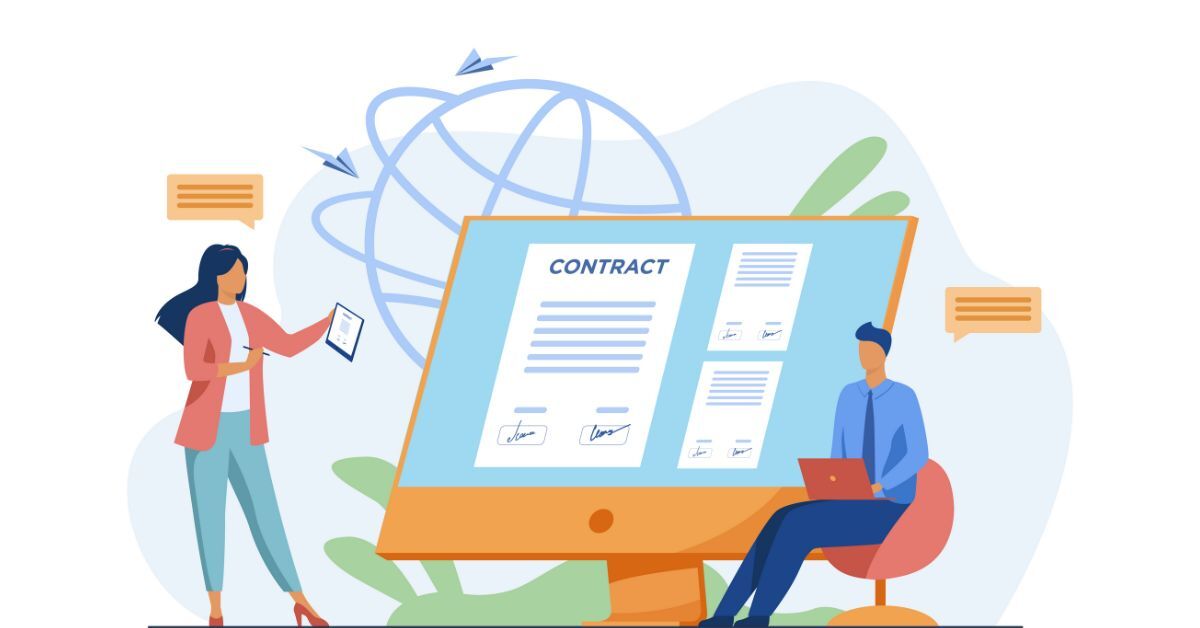Contract Workflow
Contract workflow has become mostly a technical task due to digital improvements. Implementing a streamlined contract processing process helps firms comply and act quickly by reducing legal risks and increasing productivity.
This article will examine the importance of a good contract workflow, go over its essential processes, go over typical roadblocks, highlight the advantages of automating the process, and offer the best practices by putting the right contract workflow software into place.
What is Contract Workflow?
A contract workflow is an end to end process of actions that need to be taken to complete a contract such as creation, revision, approval, signing, and storage. The goal is to ensure that each stakeholder uses an unchanging, open path for the handling of legal contracts.
Whether a contract is for a vendor, an NDA, or a partnership agreement, the most important thing in contract management workflow is making sure that everything is included in a good plan. This is where workflow for contract lifecycle management (CLM) becomes important.
For example:
- Vendor Contract: Procurement requests a contract → Legal drafts and reviews → Management approves → Parties sign → Stored in CLM system.
- NDA: Sales requests NDA → Uses pre-approved template → Quick legal check → E-signed → Archived securely.
- Partnership Agreement: BD team initiates draft → Legal and stakeholders review → Negotiations done → Signed → Set for renewal alerts.
Importance of Efficient Contract Workflows
Stakeholder trust, legal integrity, and organizational effectiveness all depend on effective contract procedures. A well-organized contract workflow eliminates uncertainty, speeds up implementation, and ensures that every stage, from drafting to storage, complies with both legal requirements and business regulations.
Here’s why it is important to have automated and hassle free contract workflow:
| Importance |
Description |
| Ensures Adherence to Law and Regulation |
Within a clearly defined contract workflow process, contracts undergo legal and policy checkpoints, reducing infractions, penalties, or harm to reputation. |
| Encourages Accountability |
Clear roles and duties in each step of the contract management workflow make it easier to monitor delays and ensure responsibility for tasks. |
| Enhances Transparency |
Stakeholders can monitor progress at every stage of the workflow contract management process using contract workflow software, promoting collaboration and communication. |
| Lowers Operational Hazards |
Efficient contract flow approval and contract review workflow minimize bottlenecks and missed deadlines through timely reviews and sign-offs. |
| Facilitates Strategic Decisions |
Centralized contract data managed via workflow for contract lifecycle management provides insights and audits for better renegotiation and trend analysis. |
Note: According to the International Association for Contract & Commercial Management (IACCM), currently known as World Commerce & Contracting, businesses lose an average of 9% of their yearly income owing to contract value leakage.
Contract Workflow Steps
A standard contract workflow processincludes the following stages:
| Steps |
Description |
| Contract Request |
The contract workflow process begins with a stakeholder or department submitting a contract request, detailing purpose, type, terms, and deadlines. Modern contract workflow software provides request portals/forms to capture this data accurately before drafting. |
| Drafting |
The approved request moves to drafting, where the initial contract document is created using templates or previous agreements. Contract management lifecycle tools automate standard clauses and track compliance, helping legal teams draft with efficiency. |
| Contract Review Workflow |
Draft contracts are reviewed by legal, compliance, finance, and business units for accuracy, risk, and policy alignment. Contract workflow software automates tracking edits, compiling feedback, and maintaining version history. |
| Approval Stage (Contract Approval Workflow) |
After review, contracts reach the approval stage. Automated systems route contracts to authorized approvers based on criteria like value or category, reducing bottlenecks and ensuring governance. |
| Negotiation (Contract Negotiation Workflow) |
Negotiation begins if provisions need changes or if the counterparty requests adjustments. Secure portals in contract workflow software facilitate collaboration, track versions, and manage differences efficiently. |
| Signing and Execution |
Once terms are agreed, contracts go to the signing stage. Digital signature features ensure quick, secure, and legal execution and provide a trail for authenticity within the contract management software workflow process. |
| Storage & Retrieval |
Signed contracts are stored in a centralized repository. Contract workflow software enables fast retrieval for reference, audit, or compliance. Central storage maintains data integrity and prevents loss. |
| Contract Renewal Workflow |
Automated workflows track contract renewal dates, notify relevant teams, and manage renegotiation or extension efficiently, helping avoid service lapses or missed deadlines. |
What are the Key Stages of the Contract Process?
The following are the steps or key stages of contract workflow:
| Stages |
Descriptions |
| Contract Drafting |
The initial part of the contract cycle involves writing the contract, covering parties, work scope, payment terms, and conditions. Standard templates are often used to complete this stage in the contract management process. |
| Contract Approval |
After drafting, the contract enters the contract approval workflow where legal, finance, and leadership teams review and approve it to ensure compliance, risk mitigation, and business alignment. |
| Contract Execution |
In this stage, parties who have agreed to the negotiation sign the contract, finalizing the agreement and affirming that all terms are legally binding and enforceable. |
| Signing |
Traditionally a physical process, signing is now conducted electronically via contract workflow software, enabling faster execution and remote collaboration among stakeholders. |
| Contract Monitoring and Management |
Once signed, the contract enters the contract management workflow. Teams monitor deliverables, performance, timelines, and compliance to ensure responsibilities are met. |
| Contract Renewal or Termination |
Based on performance and terms, the contract may be renewed or terminated. A strong contract renewal process ensures important dates are tracked and renegotiations occur timely. |
Common Contract Workflow Challenges
Despite its significance, a lot of companies have difficulties with business process contract management software workflow, such as:
- Version discrepancies and manual errors.
- Delays are brought on by ineffective approval processes.
- Inability to see the status of the contract.
- Risks to compliance from omitted dates or clauses.
The necessity of an automated CLM workflow strategy is highlighted by these problems.
Why Do Businesses Need to Update Their Contract Workflows?
Modern businesses need to adjust to operating digitally first. Outdated workflows pose dangers in addition to slowing down procedures. This finding is further supported by data from Infosys BPM, which shows that contractual inefficiencies can cost companies almost $1.5 million in lost revenue possibilities.
Businesses benefit from investing in an effective workflow for contract lifecycle management in the following ways:
- Fulfill the standards for compliance.
- Maintain version control for the contract.
- Cut down on overhead.
- Assist teams that are remote or hybrid.
What are the Benefits of a Good Contract Workflow?
A robust contract management flow can transform your legal operations. Here are some critical advantages:
1. Eliminates Bottlenecks
A well-structured contract workflow avoids manual errors and assures compliance at all stages of the contract lifecycle, from creation and approval to progress monitoring. Organizations can prevent misunderstanding and delays by clearly outlining their roles, responsibilities, and processes. This clarity enables teams to focus on strategic tasks that support business success using workflow for contract management.
2. Speeds up Contract Creation:
Manual processes, such as finding stakeholders and updating spreadsheets, are inefficient. An efficient contract management cycle procedure replaces these repetitive tasks using modern workflow software, significantly improving the speed of contract creation.
3. Improves Contract Turnaround Time:
Contract turnaround time (HAT) is one of the most crucial aspects in completing a transaction. Automating contract management software workflow allows organizations to reduce the time it takes to create, evaluate, and approve contracts. This time-saving strategy ensures that contracts are sent to the right parties for assessment and approval.
4. Reduces Operational Costs:
Streamlined workflow contract management reduces the need for human labour, greatly lowering administrative costs. Contract management systems eliminate the need for considerable human participation in routine tasks, resulting in cheaper labour costs. Furthermore, automation reduces errors and delays, which contributes to cost savings and better resource allocation.
5. Improves Contract Compliance:
Preparing a strong contract management workflow assures the usage of pre-approved provisions, accurate documentation, and comprehensive review. This systematic approach assists organisations in maintaining compliance and reducing the possibility of errors that could disrupt corporate operations. Although optimized operations improve speed and efficiency, many firms still confront challenges making contract Lifecycle management software for business a very important investment.
Contract Management Workflow with Legistify
From creation to renewal, Legistify’s comprehensive contract workflow software centralizes the complete process. It guarantees a smooth contract management process that is suited to your company’s requirements, thanks to AI-driven capabilities and customizable templates.
- Automation of the intelligent CLM workflow.
- Integrated contract review workflow.
- Dashboards for monitoring in real time.
- Solutions that are scalable for businesses of all sizes.
Best Practices for Optimizing Contract Workflows
To enhance your contract workflow process, follow these best practices:
- Standardize Templates: To save duplication of effort.
- Automate Approvals: Make use of the contract approval workflow.
- Use Version Control: Make sure you only distribute the most recent version of the document.
- Set KPIs: To track turnaround time, renewals, and approvals.
- Employee Training: Introduce users to the contract management lifecycle.
How to Improve Your Contract Workflow?
Identifying bottlenecks is the first step to improving contract lifecycle management process. Here are some techniques you can implement:
- Utilize a cloud platform for contract workflow software.
- Integrate e-signature capabilities for prompt execution.
- Automate the deadlines and renewal reminders.
- Provide custom user roles and access control settings.
Looking to Remove Bottlenecks from Your Contract Workflow?
Typical bottlenecks in the contract management lifecycle include:
- Awaiting approvals.
- Communication threads are lost.
- Documents that are missing.
These problems can be resolved with a centralized contract management software that includes capabilities like:
- Routing rules that operate automatically.
- Audit traces.
- Alerts and triggers for escalation.
Advantages of Contract Workflow Automation
The Goldman Sachs report says that the use of automation for contract management will:
- Obsolete secure negotiations in as little as half the time.
- Diminish inaccurate payments to a point lower than 90%.
- Reduce contract management operating and processing costs by 10% to 30%.
Key benefits include:
- Shorter turnaround periods.
- Reduced likelihood of non-compliance.
- Improved scalability for expanding groups.
- Improved insights and analytics.
Streamlines Contract Workflows With Legistify’s Contract Management Software
Legistify provides software with modern version of contract management software which provides the following features:
- Centralised dashboards.
- Integrated negotiation and review tools.
- Workflow triggers based on roles.
- Real-time status updates.
The implementation of contract lifecycle management process in businesses leads to the avoidance of delays and the reduction of manual work.
Accelerate Your Contract Lifecycle Automation
To soothe your contract lifecycle management (CLM) process, you can automate your contract cycle with the help of contract management software. Using this software will help you accelerate the entire contract management process — from contract requests to contract creation, contract negotiations, and finally, contract execution.
Important Tips To Accelerate Your Contract Workflow
As you approach your business processes, consider these tips to accelerate your contract workflow:
- Ensuring Data Quality and Consistency: Automation relies heavily on quality data. Without clean, verified, and current data, automated workflows may produce inaccurate results, affecting efficiency and decision-making.
- Employee Adaptation and Training Challenges: Employee buy-in is essential for automation success. Providing comprehensive training and support ensures that employees are comfortable with the new workflows, which reduces resistance and improves engagement.
- Technological Integration Issues: Integrating diverse systems is a major hurdle. Especially with legacy systems, bridging the gap between old and new technology requires careful planning and resource allocation to ensure seamless integration.
- Addressing Security and Privacy Concerns: With automation involving sensitive data, ensuring robust cybersecurity is critical. Measures like firewalls, data encryption, and continuous monitoring help mitigate these risks and protect business data.
The efficiency of automation depends on the instruments you employ. Select contract lifecycle management software for your company that has the following features:
- Adaptable integrations.
- Personalized workflow setups.
- Access based on roles.
- Safekeeping of documents.
Seek out platforms that provide software for scalable contract workflows that can expand to meet your company’s needs.
Future Trends in Contract Management Workflow Automation
Contract lifecycle management is rapidly evolving, driven by the advent of emerging technologies that are reshaping how organizations approach their workflows. Key technologies such as artificial intelligence (AI), machine learning, blockchain, and cloud computing are set to have a profound impact on contract management processes.
- AI and Machine Learning: It can enhance contract analysis by automatically extracting key terms, identifying risks, and suggesting optimizations based on historical data. This not only speeds up the review process but also improves accuracy, allowing legal teams to focus on more strategic tasks.
- Blockchain Technology: This technology offers the potential for increased transparency and security in contract management. Smart contracts—self-executing contracts with the terms of the agreement directly written into code—can automate contract execution and ensure that all parties adhere to the agreed-upon terms without the need for intermediaries.
- Cloud Computing: It facilitates greater accessibility and collaboration, allowing teams to manage contracts from anywhere, at any time. This flexibility is essential in today’s remote working environment, enabling organizations to streamline their workflows and maintain productivity.
The global contract lifecycle management software market is estimated to be valued at USD 2.89 billion in 2025 and is expected to reach USD 6.81 billion by 2032, exhibiting a compound annual growth rate (CAGR) of 13.0% from 2025 to 2032.
Latest Report, titled “Contract Lifecycle Management Software Market” Trends, Share, Size, Growth, Opportunity and Forecast 2025-2032, by Coherent Market Insights, offers a comprehensive analysis of the industry, which comprises insights on the market analysis. The report also includes competitor and regional analysis, and contemporary advancements in the market.
Summing Up
Whether you are in charge of managing the thousands of contracts that you have or just a few critical ones, integrating the right contract workflow software into your system guarantees that your process for contract lifecycle management will be as scalable, secure, and efficient as possible.
By leveraging platforms like Legistify, businesses can automate, optimise, and future-proof their contract management process for years to come. Contact us and we will send you the contract workflow pdf along with tips and tricks to manage and automate the process.




